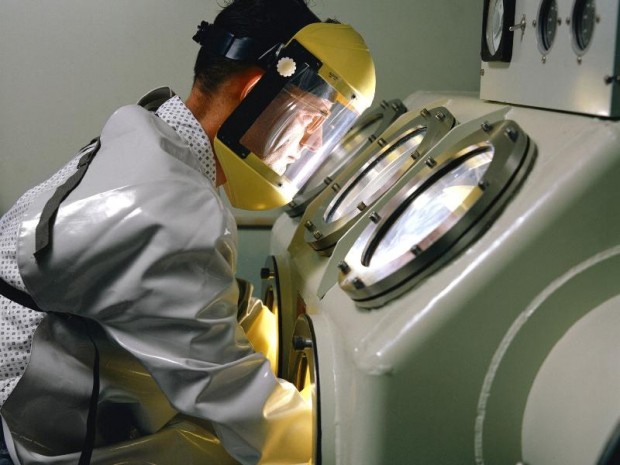Little is clear in the churning aftermath of NASA’s much-ballyhooed announcement of the discovery of arsenic-tolerant microbes in the mud of California’s Mono Lake. As I’ve said here previously, those results�if correct�could change the very definition of life (something which happens with more regularity than the sensational nature of the formulation would seem to imply). As those findings are scrutinized, however, it’s becoming clear that biology students will be safe in choosing used textbooks, at least for a little while longer.
From a purely scientific viewpoint, that’s not a bad thing: as Dave Munger observes in a piece at SEED, “A single study rarely causes a revolution in science all on its own.” NASA’s public-relations planners would do well to take Munger’s observation as a motto, and adopt a more conservative approach to the announcement of results in basic science.
Munger argues that the episode, which one might be tempted to call “arsenicgate,” has more to say about science journalism than the current state of astrobiology, the multi-disciplinary study of the conditions in which life might exist beyond Earth’s clement harbor. But it also has proven a revealing experiment in the sociology and politics of science.
Professional tensions were apparent at the press conference�indeed, the event appeared structured to exploit them. The scientists on hand to interpret the findings�Felisa Wolfe-Simon, the young geomicrobiologist who discovered the bacterium; and Steven Benner, a senior biochemist active in astrobiology�both coolly struggled to avoid conflict. But their discourse cycled dramatically between code and candor. Benner repeatedly (and entirely correctly) called the results “exceptional“�which to scientists means not “awesome” but “unlikely to be true.” (Wolfe-Simon responded that as a scientist and a human being, she is “interested in exceptions.”) Several times Benner referred to the “different standards of proof” that obtain in microbiology and biochemistry; while he meant the necessarily-varied protocols and experimental results native to each discipline, it was hard not to infer that from where Benner was sitting, some criteria are better than others.
Wolfe-Simon, too, demonstrated the perfectly-human proclivities to which scientists, like the rest of us, are prone, expressing her pleasure at the career-making nature of her discovery (the name of the new bacterium, GFAJ-1, has been said to stand for “Give Felisa A Job”)�and her awareness of the skepticism that an ambitious junior researcher’s findings would invariably face. While Wolfe-Simon’s remarks stressed the wonder of science, Benner’s discussion offered a quiet tutelage in the slow, multi-disciplinary agon by which science gradually arrives at new understandings of the natural world. I found both perspectives bracing.
But if tension crackled at the press conference, it has flared brightly in its aftermath. And embargo-delayed journalists practicing due diligence by calling upon researchers to review Wolfe-Simon’s findings can’t help fanning the flames. Carl Zimmer’s piece at Slate, “This Paper Should Not Have Been Published,” is an indispensable guide to the study’s potential problems�and as its provocative title indicates, it also lets the sort of ad-hominem jabs that would normally only be heard in faculty common rooms and in the halls between conference meetings bubble over into the public sphere. One of the scientists Zimmer quotes, Norman Pace of the University of Colorado, points to “naive investigators and bad reviewers” as the “real story” of this research. Zimmer also quotes microbiologist Rosie Redfield, whose sharp and thorough critique of Wolfe-Simon’s paper has been widely linked-to, tweeted, and otherwise shared around, calling the results “flim-flam” and stating that were it up to her, Wolfe-Simon would be ordered, like an overeager graduate student, to go back and try again.
Pace and Redfield may be correct�and yet the tenor of their statements exposes tremors in the normally-placid face science presents to the public. But we should bear in mind that while science is not properly conducted by press release, neither does it proceed by means of outrage and insult. It’s not that such responses are wrong, or that scientists should be above them. It’s one of the marvels of science that its institutions, its rites and rituals, should provide practical safeguards against the real and unavoidable emotional responses that scientists�as questing, feeling persons�are bound to have. The critical reception of Wolfe-Simon’s findings is only a prelude to the coming work of reproducing her results and conducting further experiments�a months-long process from grant-writing to the culturing of bacteria to peer review.
In retrospect, Benner and Wolfe-Simon were set up by NASA, an agency eager to flog every finding as tantamount to the discovery of extraterrestrial life; and Science, a journal that uses embargoes to enforce its knowledge monopoly. The scientists’ onstage tensions, like the grumblings of colleagues elsewhere, are entirely healthy expressions of the human reality of science�but perhaps a NASA press conference was not their ideal setting. Results like Wolfe-Simon’s would be better presented in a journal committed to open access. In future, NASA would do well to let the process play out before calling for the biology textbooks to be rewritten.
 Gearfuse Technology, Science, Culture & More
Gearfuse Technology, Science, Culture & More




As you point out, this is actually a microbial-scale window into a much bigger problem.
We tend to think of science as an ongoing catalogue of greatest hits. And magic ones, at that. It may be a legacy of midcentury cataclysmic metaphors: the bomb, the big bang, the first man on the moon� But be that as it may, when a new proto-hit is announced, (�NASA discovers life!�), at first we inflate with the news or the anticipation thereof, and then just as quickly deflate when the revealed factoid is (a) not a hit, and (b) maybe not even a factoid. It�s part of the faith-based dynamic that is very much at work even in the most stringently secular parts of our world; we want to believe, science promises an object for that belief (or has in the past), and we are correspondingly disappointed when yet another �reveal� turns out to be just a small, perhaps inconclusive result, brewing in an all-too-familiar soup of petty squabbling. Science can�t be magic when it�s just like decisions by committee and endless project management meetings. And the disappointment poisons our appreciation for what science actually is, how it is actually done, and what it can actually do for us. Forlorn, we seek magic elsewhere, and that way lies madness.
But as you draw out in your analysis, the answer is to pay LOTS of attention to the men (and women) �behind the curtain.� Historically I don�t think the practice of science or proto-science was so much about a public holding its breath for the world to be turned upside down, again; the process of understanding our world takes place on a much less cataclysmic, ordinary level (and should!), most of the time. Science is a human endeavor, like business, like fashion design, like anything else we do; in this, the project-management scenario is not only the norm, but is something to appreciate, not be disappointed in. It also signposts the accessibility of scientific practice; it is not something practiced by magic wizards in sterile caves. We can understand it. We can DO it. And the petty squabbles? Perhaps not so petty, as we work out interpretations and workflows and details, and in any case, those go along with the territory. All our territories.
I think Neal Stephenson�s �Baroque Cycle� captured this nicely (if not as briefly); by focusing on Daniel Waterhouse instead of Isaac Newton as the main character, it was an almost 3,000-page celebration and contextualization of the Project Manager, that integral yet largely unsung hero of the scientific method. We need to believe — in ourselves.